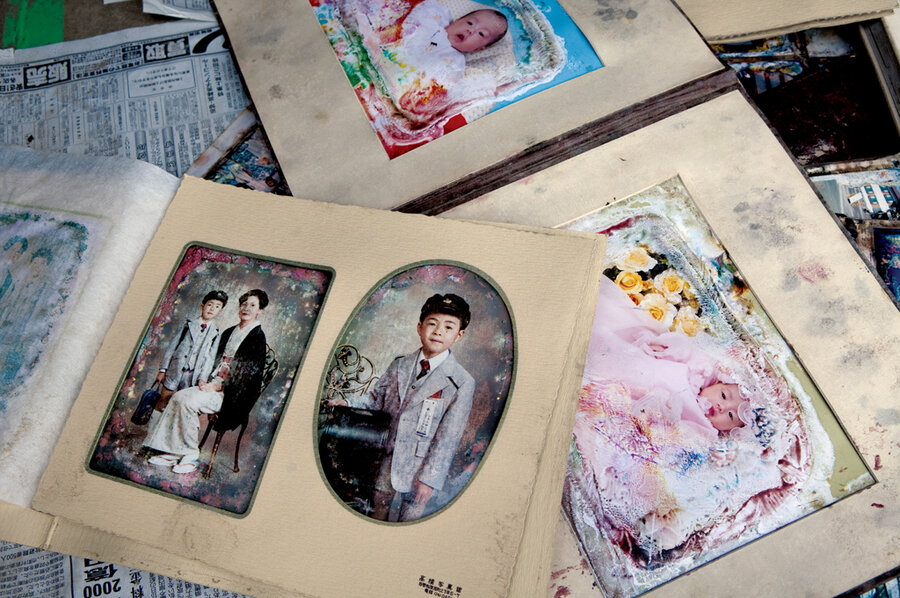R U there, Marcel Proust?
Loading...
Memory triggers, à la Proust, are going the way of the daguerreotype. Or the Polaroid. Even as we marvel at technology, we might wonder about the future of "madeleine moments." So much of our world appears in the same resolution in the same format on the same screen. What unique stimuli will grab us and take us back in time?
I looked at one of our old family photo albums recently. Maroon leather, black pages, and those little paper corners to hold the photos in place. Just touching the worn cover, I am brought back to a day when I was about 7 years old. I had tiptoed into the inner sanctum of my mother's bedroom, where the album was kept in a trunk at the back of the closet. My mother is sitting in front of a mirrored vanity, toying with an atomizer of Shalimar. She gets up. I can still hear the creak of the hinge when she opens the trunk and takes out the precious album. She folds me into the crook of her arm as we turn the pages.
As an adult, I keep our family photos organized by date and subject in "albums" and "events" on my computer, synchronized with my smart phone. Kids at Halloween. Trip to Turks and Caicos. Always available. There are literally thousands of digital images, but few of them tingle my senses. None of them is etched into my mind in the same way as the three sepia-tinged, girlhood photos of my mother, all taken at a photographer's studio.
And what about maps?
"Time to look at the map," my father would say on our annual car trip to visit cousins in New Hampshire.
"Do you mean the map with the coffee stain around Nashua or the other one that's missing part of Massachusetts?" I would ask. I took my job as navigator seriously.
"Either one," my father would answer. Even today, just seeing the words Rand McNally can evoke the soft gray upholstery of my father's 1956 Packard. Sitting between my parents on the wide front seat, I'd reach over to the glove compartment, pungent with the smell of the anise-flavored Pine Bros. cough drops my father kept there.
Will our grandchildren fondly recall the voice of the GPS unit stating, "You have arrived."
My mother-in-law's recipe for brownies was typed on a little blue aerogramme. I had asked her to mail it to me when I was first married and living abroad. My husband was nostalgic for American brownies, the superfudgy kind.
I came across that aerogrammerecently in a bulging file of recipes. It has chocolate fingerprints on it – my own and my children's. Upon holding it in my hand, I breathe in and immediately recall the damp smell of our Swiss apartment, the yellow ceramic baking pan in the kitchen, the sound of the landlady beating her rugs.
I keep a lot of recipes now on my computer. It's neat and convenient. But these perfectly alphabetized recipes don't take me on any surprising journeys into the past. Not one of them compares to finding scribbled directions for clafoutis, written by a neighbor in the middle of a book club meeting. Or the mimeographed recipe for pumpkin tea bread that was provided by my son's kindergarten teacher and has been used every Thanksgiving since.
I won't even talk about letters. Onion-skin missives from my beloved older brother, scrawled hastily while he was serving in the US Air Force. I find one in a box in the attic and the return addresses come back to me in a flash. Or postcards from my first boyfriend with views of Cornell University and Cayuga Lake. Turning one of those over brings me back to the summer before that sweet young man left for college. His lips were chapped from working in the hot sun as a golf caddy. His neck smelled of soap.
Today I text my own granddaughter and she responds "C U SOON, GRAN." My message back is "personalized" with a photo and my electronic signature and "LUV 2 U." She knows that I miss her, but she doesn't know about all the other epistolary things I miss. Children's notes written with waxy crayons, exotic postmarks, cartoons, and dried flowers stuffed into envelopes.
When Proust's narrator tasted the madeleine, he was transported back to Combray. But what about a photo of the traditional cookie, compressed into a JPEG file, reproducible at 300 pixels per inch? Would that have done the trick?





